
Apulia, also known by its Italian name Puglia, is a region of Italy, located in the southern peninsular section of the country, bordering the Adriatic Sea to the east, the Strait of Otranto and Ionian Sea to the southeast and the Gulf of Taranto to the south. The region comprises 19,345 square kilometers (7,469 sq mi), and its population is about four million people. It is bordered by the other Italian regions of Molise to the north, Campania to the west, and Basilicata to the southwest. Its chief town is Bari.
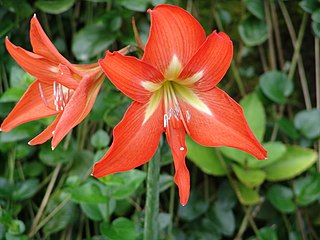
Hippeastrum is a genus of about 90 species and over 600 hybrids and cultivars of perennial herbaceous bulbous plants. They generally have large fleshy bulbs and tall broad leaves, generally evergreen, and large red or purple flowers.

Hyacinthus is a small genus of bulbous, spring-blooming perennials. They are fragrant flowering plants in the family Asparagaceae, subfamily Scilloideae and are commonly called hyacinths. The genus is native to the area of the eastern Mediterranean from the south of Turkey to Israel/Palestine, although naturalized more widely.
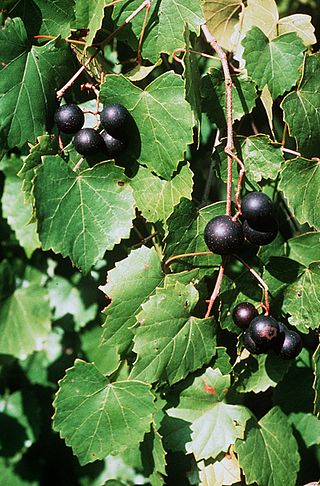
Vitis rotundifolia, or muscadine, is a grapevine species native to the southeastern and south-central United States. The growth range extends from Florida to New Jersey coast, and west to eastern Texas and Oklahoma. It has been extensively cultivated since the 16th century. The plants are well-adapted to their native warm and humid climate; they need fewer chilling hours than better known varieties, and thrive in summer heat.
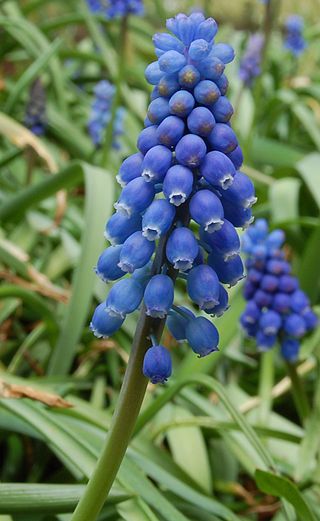
Muscari is a genus of perennial bulbous plants native to Eurasia that produce spikes of dense, most commonly blue, urn-shaped flowers resembling bunches of grapes in the spring. The common name for the genus is grape hyacinth, but they should not be confused with hyacinths. A number of species of Muscari are used as ornamental garden plants.

Muscari racemosum is a perennial bulbous flowering plant in the asparagus family Asparagaceae. The members of the genus are commonly known as grape hyacinths. Originally from south-west Turkey where it grows in rocky places, it is sometimes grown as an ornamental plant. It may be found in the horticultural literature under the synonym Muscari muscarimi.

Bellevalia is a genus of plants in the family Asparagaceae, subfamily Scilloideae. It was first described as a genus in 1808.

Muscari botryoides is a bulbous perennial plant of the genus Muscari and one of a number of species and genera known as grape hyacinth. It is sometimes grown as an ornamental plant.

Eucomis comosa, the pineapple flower, pineapple lily or wine eucomis, is a species of flowering plant in the asparagus family Asparagaceae. A deciduous bulbous perennial used as an ornamental plant, it is endemic to South Africa. The white to purple flowers appear in summer and are arranged in a spike (raceme), topped by a "head" of green leaflike bracts.

Muscari neglectum is a perennial bulbous flowering plant in the asparagus family Asparagaceae. Members of this genus are commonly known as grape hyacinths, and M. neglectum is known as common grape hyacinth or starch grape hyacinth. Muscari are perennial bulbous plants native to Eurasia. They produce spikes of dense, commonly blue, urn-shaped flowers. It is sometimes grown as an ornamental plant, for example, in temperate climates as a spring bulb.
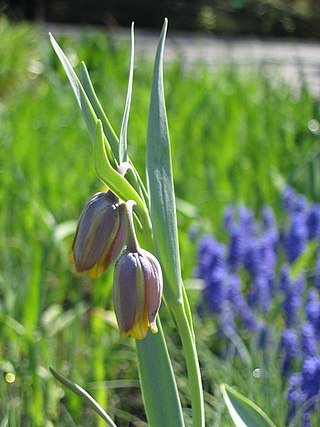
Fritillaria uva-vulpis, commonly called the fox's grape fritillary, is a bulbous perennial plant belonging to the genus Fritillaria and native to eastern Turkey, north-western Iraq and western Iran. They are mainly found in the wooded foothills of the Zagros, where they grow in damp meadows and cornfields between 900 and 1800 m above sea level.

Muscari armeniacum is a species of flowering plant in the squill subfamily Scilloideae of the asparagus family Asparagaceae. It is a bulbous perennial with basal, simple leaves and short flowering stems. It is one of a number of species and genera known as grape hyacinth, in this case Armenian grape hyacinth or garden grape-hyacinth. The flowers are purple, blue, white or pale pink and the plants are usually 15 centimetres (6 in) tall. M. armeniacum blooms in mid-Spring for 3–4 weeks. Some selections are fragrant. Established bulbs leaf in the autumn. M. armeniacum is widespread in the woods and meadows of the Eastern Mediterranean, from Greece and Turkey to the Caucasus, including Armenia which gives it its name.
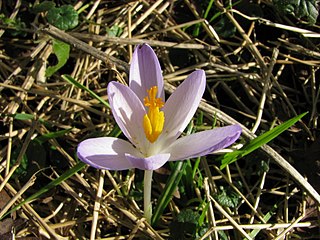
Crocus tommasinianus, the woodland crocus, early crocus, or Tommasini's crocus, is a flower named after the botanist Muzio G. Spirito de Tommasini (1794-1879). It is native to Bulgaria, Hungary, Albania, and the former Yugoslavia. It is often referred to as the early or snow crocus, but these terms are shared with several other species, although C. tommasinianus is amongst the first to bloom. Multiple plants are often called tommies in the horticultural trade.

Liriope muscari is a species of flowering plant from East Asia. Common names in English include big blue lilyturf, lilyturf, border grass, and monkey grass. This small herbaceous perennial has grass-like evergreen foliage and lilac-purple flowers which produce single-seeded berries on a spike in the fall. It is invasive to North America and considered a threat to native wildlife.

Leopoldia is a genus of bulbous perennial plants in the family Asparagaceae, subfamily Scilloideae. The genus is widespread around the Mediterranean region and neighboring lands, from the Canary Islands to Iran.

Muscari macrocarpum is a perennial bulbous flowering plant in the asparagus family Asparagaceae. It is one of a number of species known as Grape Hyacinth, in this case Yellow Grape Hyacinth. Originally from eastern Crete, Amorgos and south-west Turkey, where it grows in rocky places, it is sometimes grown as an ornamental plant.

Muscari aucheri, Aucher-Éloy grape hyacinth, is a species of flowering plant in the squill subfamily Scilloideae of the asparagus family Asparagaceae. It is a perennial bulbous plant, one of a number of species and genera known as grape hyacinths. Originally from Turkey, where it grows in grassy alpine areas, it is sometimes grown as an ornamental plant. The synonym M. tubergenianum may be found in the horticultural literature.
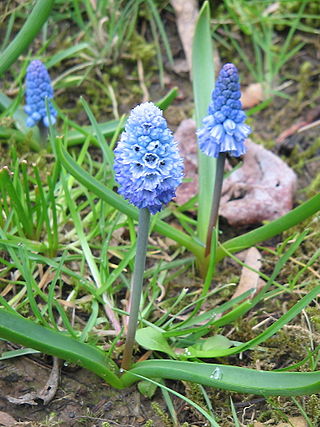
Pseudomuscari azureum, the azure grape hyacinth, is a species of flowering plant in the family Asparagaceae, native to Turkey. A bulbous perennial, it is grown in gardens for its spring flowers. The Latin specific epithet azureum means "bright blue", a reference to its flower colour.

Muscari latifolium, the broad-leaved grape hyacinth, is a species of flowering plant in the family Asparagaceae. The Latin specific epithet latifolium means "broad-leaved".
Bellevalia paradoxa is a bulb forming plant in the genus Bellevalia of the family Asparagaceae, formerly classified in the genus Muscari, under which name it is commonly sold as Muscari paradoxum.

























